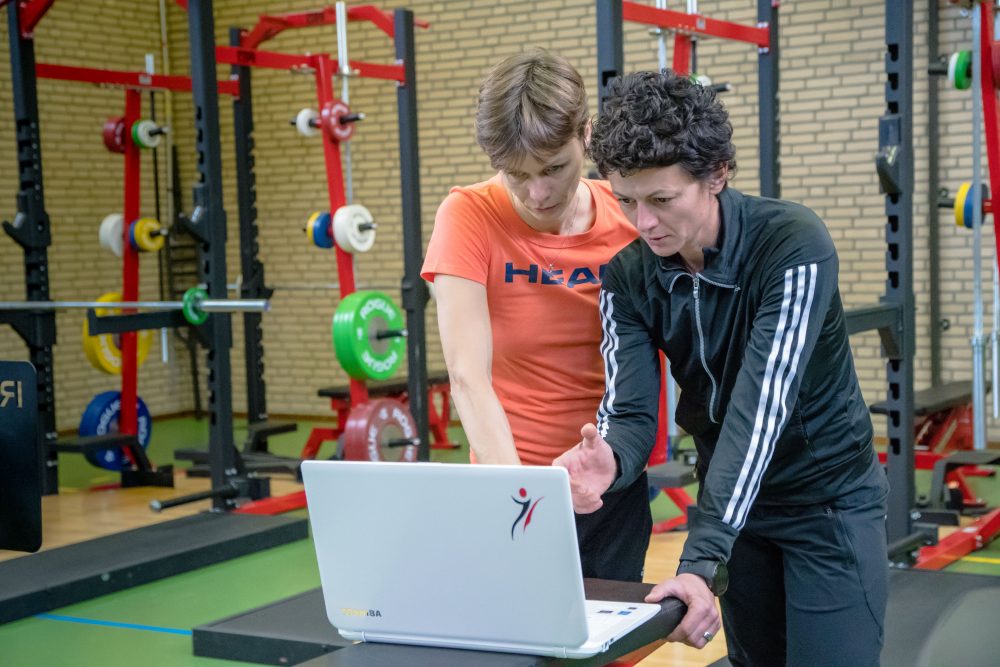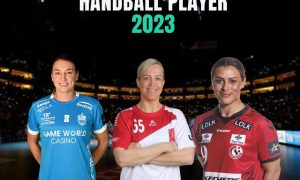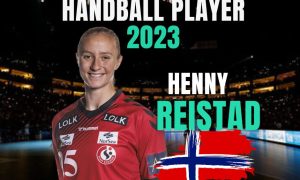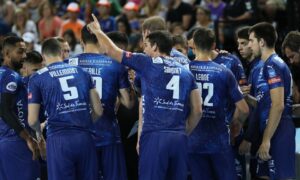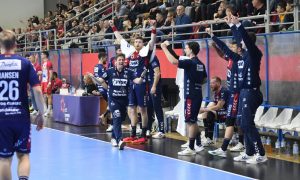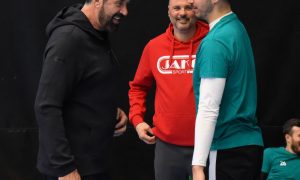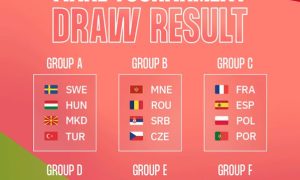In this totally specific year, including handball season, staying healthy is bigger challenge than ever; therefore, we spoke with two experts in physical preparation of top athletes, professors who live and work in the Netherlands for many years, Maja Ivanović and Tanja Šarenac (Total Movement). In the first part of the interview, we have got some precise answers from the field of their expertise, starting with injuries through recovery to nutrition and supplements. While the second part of the conversation considers engagement in ŽRK Budućnost, Veszprem and as well as unplanned and unexpected interrupted project in Podgorica.
WE TREAT THE ATHLETE NOT AN INJURY
Not a small number of athletes have gone with you through the recovery process in last few years. What does your methodology consist of and why has it proved more successful than others?
The shortest possible answer would be: “Because we treat the athlete, not the injury.” Of course, at the very beginning we analyze the mechanism of the injury, the affected tissues and their status, and surgical or other medical intervention, if it is done. Then we build the complete picture by analyzing each functional system and subsystem, as well as the habits of the athlete, primarily in diet and lifestyle. The recovery goes in three basic directions: 1. treatment of the affected tissue, 2. progressive training of all systems and subsystems to the level necessary for a successful return to the playground – without compromising the recovery of the affected tissue, 3. creating new habits – from pain perception, through habits in diet, life, etc.
IF I KNEW THIS WHEN I WAS 15
With what levels of body self-caring awareness have you encountered in the world of handball professionals?
From total carelessness to obsessive care about every detail. Joke aside, not many handball professionals understand and accept serious work on their body. Very often we meet with the comment of mature players who are recovering here: “Well, if I had started doing all this when I was 15-16 years old…” That says a lot. Body care is learned through the process of creating the right habits! It is a process that should start very early and involve not only the players and their coaches, but also the parents. But what does the child know what is the best for him / her? That is why a huge responsibility lies on all of us who are involved in the development of athletes. Mistakes made in early development can have huge consequences later, not only on the sports career, but also on the entire personality and life of the athlete. The solution lies in a good system and educated and motivated coaches, as well as other experts involved in the development of athletes.
HANDBALL IS GROWING, PHYSICAL DEMANDS ARE INCREASING, BUT POTENTIALS REMAIN UNUSED
How fast is changing and how fast is implementing new knowledge in your field?
Compared to individual sports, then rugby, basketball, even though football, handball is behind schedule in terms of implementing new knowledge. Compared to other sports, handball, especially women’s handball, has very little well-founded research and experiments. Even the knowledge about handball, which has been in the scientific literature for a long time, is poorly and slowly implemented. On the other hand, knowledge from other sports, although very purposeful, often is not even considered as potential training content for handball players. Handball is growing and growing, and physical demands are increasing, and players are entering in mature playing years with accumulated injuries and they have never achieved maximum potential. Serious work on physical preparation in handball must begin very early. Players must acquire habits to the level of addiction at a very early age.
WHEN WE NO LONGER HAVE WILL AND DESIRE TO INVEST TIME AND MONEY IN NEW KNOWLEDGE, WE SHOULD STOP WITH WORK
Where do you draw new knowledge from and how long does it take to test and put into the process some of it?
Today, it is impossible to read everything that is published in science and profession that has something to do with our work. That’s why we have a dozen platforms that help us filter out new knowledge. Each new scientific article of special importance is further downloaded in full text on other platforms. All of these platforms require investments and efforts, but it is an integral part of the job. When we no longer have will and desire to invest both time and money in upgrading and new knowledge, we should stop doing this work.
Generally, we insert new knowledge and technologies into the process very quickly. Of course, we tend to do that with those athletes who are at that level. Because, too much – too soon, is not good at all. Recently, we have been working on the application of a mobile system for measuring gas exchange. We experiment a lot with direct EMG feedback, and the feedback from 3D force plates, all in terms of accelerating the change of motor patterns, especially in the rehabilitation of shoulder, back and knee injuries. In the next year or two, we are planning series of publications on various topics related to the physical preparation and nutrition of handball players. We also have planned potential research projects, especially in women’s handball, but we certainly need to figure out the process of financing such projects.
IT IS POSSIBLE TO OVERCOME THE SEPARATION OF HALL – GYM TRAINING
How do you see the most optimal application of general knowledge and specific methods for the development of handball players?
In every sport, including handball, those who manage to adapt and adjust resources and logistics in such way as to combine technical, tactical, mental and physical preparation into a single process of planning, work and monitoring, will make an incredibly big step and unattainable result. Separation of training, like the hall – gym system, should be overcome. Certain methods of physical preparation can be perfectly combined in handball training, in improving technical elements, in situational conditioning, even in learning and improving group and individual tactics. If our dream of a long project in handball came true, then we could surely manage to upgrade and perfect such a system. That is why, after all, we study handball intensively.
EX-YU REGION ABOVE AVERAGE GIFTED FOR TOP SPORTS
What role does character or mentality play, and what role does genetics play in the training process?
We are all born with certain genetic predispositions. Even some personality traits are coded in our genome. But how exactly all these predispositions will express depends on the environment, social and other influences. Some physical predisposition we cannot influence by training a lot, but we can maximize the conditions for the desired predispositions to develop to the maximum. This is why there is sport’s selection/orientation, and specific organization of training in respect to the requirements of a sport.
On the other hand, most character traits can be changed and channeled. Let’s not forget that children today, from the earliest age, have very few optimal influences on the manifestation of physical and mental characteristics needed for top sports achievements. We must take special care of this when selecting and choosing training systems and methods. In other words, if a tall, not very skilled girl appears to us, who cannot really throw the ball or jump far, or cannot run fast or long – let’s not reject her. Let’s wait and see how much and how quickly she will adapt to the optimally set training process. We never know what was or was not available to a child in his/her early development.
Considering that we have been working internationally in many sports for almost twenty years, accumulating a huge database, we can objectively conclude that children from the former Yugoslavia, especially the Dinaric region, are above average gifted or predisposed to top sports. Only from the organization and investment in the timely and optimal training process, it depends on whether that potential will develop in a top athlete.
PERFORMANCE NUTRITION AS A KEY ASPECT OF THE TRAINING PROCESS
There is little talk about the connection between quality and planned nutrition with training, matches and general health?
There is not much being said regarding the connection between athlete’s diet quality and well balanced, periodized and planned performance nutrition, that goes in line with training, games and supports athlete’s general health, immunity and tissue quality.
Firstly, well-balanced healthy diet and then specific performance nutrition are, unfortunately, still an insufficiently current topic in handball, both men and women. In our opinion, the adequate diet, one that supports athletic performance is one of the most important aspects of the training process. Without it, desired adaptations to specific training stimuli are greatly compromised, and in some cases impossible. Not to mention compromised recovery and not performing on one’s highest potential.
Our first and basic task in the process of optimizing a specific sports diet is education about the exact impact of nutrition on the immune system and overall health, on the desired adaptations to training stimuli, on tissue quality, on recovery, etc. We also educate our athletes how to choose, prepare and consume well balanced nourishing meals. In other words, we teach them how to fuel their performance; when, how much and what to consume in relation to the requirements of the training and/or the rehabilitation process; we teach them how to properly hydrate and monitor their hydration status; wisely we choose if specific supplements should be taken and when.
Many factors are involved in diet optimization, especially sport specific. To name a few – we think about the health status of the athlete, status of acute and chronic injuries, current body composition and desired adaptations, individual goals, goals determined by part of the season, type of training unit, need for recovery, etc.
When the decision on the optimal needs is made, the most important task remains: For athletes it has to be simple, practical and not time consuming, easily achievable in their specific conditions. We coach them to form habits through the repetition of simple and applicable daily routines. As previously mentioned, healthy, well-balanced diet and sport specific nutrition enables continuity of training process, and thus directly affects the overall sports performance and provides a pillar for a long and healthy athletic career.
Recently, the number of researches related to specific sport nutrition has been growing exponentially. Our recommendations and advice are based exclusively on strong scientific evidence and are practically rounded off through a thorough study of various types of food, characteristic of various parts of the world.
Unfortunately, a large amount of semi-processed information, very often misinterpreted, spreads rapidly through the social media and brings noise and confusion. All this noise is often leading to poor decision making and do more harm than good.
BALANCED MEAL AND SLEEP QUALITY ARE BASICS OF RECOVERY
Which methods, in your experience, have proven to be most effective for recovery / regeneration after matches?
Without a dilemma, the most important are a timely and optimally balanced meal (rehydration, refueling, supplementation) and a good quality sleep! Adequate nutrients are important for tissue repair which is essential for optimal recovery between trainings and games.
All other additional methods and means are just that, additional. Their application will depend on the context. Specifically, guided cool-down and stretch – sometimes yes, sometimes no. Cooling and / or compression – sometimes yes, sometimes no. Massage and manual therapy – sometimes yes, sometimes no. Recovery training – sometimes yes, sometimes no. We also went so far that immediately after one game, we did train with a load that stimulated exactly those systems that can be stimulated in a state of fatigue. All in order to provide enough time for sleep and complete recovery, on the one hand, and maintaining the continuity of training on the other hand in a system where two or more games are played per week.
NO PILL OR SUPPLEMENT CAN REPLACE INADEQUATE NUTRITION
Your opinion on supplementation, what to take and what not to?
Supplements – yes, the first question of every athlete is about supplementation, not nutrition. In the lack of time, motivation and organizational solutions, athletes always reach for easy and fast solutions. Unfortunately, no supplement or pill, no matter how good and quality the support it was, can replace a poor and unhealthy diet. That is the basic message that we insist on our athletes to accept.
Generally speaking, we can roughly divide the supplements into two groups: 1) supplements to support and improve general health, and 2) supplements that has potential to enhance sports performance, directly and / or indirectly by improving adaptation to the training stimulus.
In order to determine possible supplements in terms of support for general health, it is our established practice that after a complete nutritional assessment, we require laboratory detection of possible deficiencies and insufficiencies of specific micronutrients.
BE AWARE OF QUALITY (BRAND) IN OMEGA-3 SUPPLEMENTATION
Let´s take Omega-3 essential fatty acids as an example. One part of the story is research proven effectiveness of Omega-3 fatty acid supplementation in supporting the cardiovascular and neuromuscular system, supporting the recovery process from training and matches, as well as the general need for supplementation due to modern diet. The second, more important part refers to the accurate detection of Omega-3 status in the individual’s body (Omega-3 index and Omega-6 / Omega-3 ratio), as well as the source and quality of the selected supplement. Most brands on the market are toxic due to the tendency of Omega-3 to oxidize quickly. Therefore, wrong selection of a poor-quality product may do more harm than good, regardless of the current need for Omega-3 supplementation.
In order to determine the possible supplements of the second group, we primarily rely on the latest studies on the efficiency and effectiveness of the selected supplement, on the quality studies of the brand itself and on the application in the context of the training process.
INDIVIDUALLY, THERE MAY BE MORE DAMAGE FROM OVERWEIGHT THAN BENEFITS FROM CREATINE
An example is a well-studied supplement, creatine. Creatine has a huge range of positive effects on sports performance in handball, but it should be recommended only in the context of individual abilities and needs. For example, one handball player may have more harm from a kilo or two of extra body weight than benefit from the effect of creatine on explosive power, while another handball player may have enormous benefits, regardless of extra body weight. That is why all our performance tests and monitoring tools are the basis for making decisions about the effectiveness of training process, body composition interventions, as well as the “simple” decision about consuming a supplement.
In this context, we would like to emphasize once again the lack of specific research in handball, especially women’s handball!
Furthermore, specific supplement products / brands from both groups can be recommended to athletes only when they have international anti-doping certificates. Doping education and WADA rules is a topic that we clearly point out every year to the athletes we work with.
THE MOST CHALLENGING PERIOD WE HAVE EVER PASSED
One specific handball season is underway with many challenges, before that it was interrupted last year. There were many different situations, interruptions, the beginning and then again interruptions, quarantine, how did you adapt and what were the reactions from the teams and professional staffs?
The end of last season and this season are the most challenging period we have ever gone through as experts in physical preparation. From the middle of March onwards, every segment of our expertise, experience, creativity and communication skills has been on the exam, each one requiring maximum of the motivation and energy.
In order to better answer these questions, we must go chronologically. In the second half of March and April, all our athletes in various sports were in, more or less, strict quarantines. We quickly distributed the available equipment to each athlete and assessed with each individual the opportunities for outdoor training. Then it was necessary to motivate everyone individually and online to explain and submit programs for very specific training summaries adapted to the needs of the training process, individual needs, conditions, equipment.
If we only take ŽRK Budućnost, then we had to work with almost thirty players on a daily basis and coordinate the process with fifteen members of the staff, management, etc. There was running in the meadows, very demanding training regimes with limited equipment at home, many interesting solutions and fun anecdotes. Since May, all athletes, including ŽRK Budućnost, have been slowly entering gyms and halls, so all logistics had to be reorganized again and the process of normal training built gradually. During that period, most of the time and energy went on motivating athletes to train continuously, because it was already certain that the season would not continue, as if there would be no Olympic Games, and that clubs would cut salaries.
The short off summer season also had to be used, not only for mental and physical rest, but also for individual preparations for the new season. New players from Budućnost were slowly getting involved here, and meeting new girls online and leading the training process without you ever seeing them live – we experienced that for the first time this summer. All in all, at the beginning of the preseason, we had a team that was physically more prepared than ever, according to all parameters, including their subjective feeling and the observations of handball coaches.
COVID PROVIDES THE COMPLETION OF THE TEAM FOR THE 4th ROUND OF THE CHAMPIONS LEAGUE
However, there was no valorization of readiness on the field. We know that Budućnost interrupted the preparations in Kolašin, and soon after that they played the first match of the Champions League without half of the team, without any joint training and preparatory match, which has never been recorded in handball.
The decision to continue the preparations in the pre-season in the training camp in Kolašin, although with an excellent plan and a top working atmosphere, quickly brought us into a very difficult situation. One case of a Covid positive player ended in a two-week quarantine for the entire team. In the first three to four days, eight more players and two staff members felt the symptoms and tested positive for Covid. All eleven had symptoms. Fortunately, no one was hospitalized. The Covid negative players spent those two weeks in home isolation and again in a special training regime, now exclusively at home. For the players who underwent Covid were required extensive medical tests, laboratory findings, examinations by internists, pulmonologists and cardiologists. The team of doctors suggested a month without training, before they were even sure to do stress tests.
All things considered, nine players were out of training for almost forty days. Only three players and two goalkeepers – who were Covid negative and have experience of playing in the Champions League – remained in training after two weeks of quarantine. Valerija Maslova came with a shoulder injury, which required special treatment and could not join the first game. Everyone already knows how the team played the first game against Podravka. In order to prevent health risks and injuries, we suggested that the cadets of Budućnost join them and try to survive the first games of the Champions League. Even the president of the club joined after a four-year break and two childbirths. Our projection was that the team could be complete with full playing time for the match with Brest at home, i.e., in the fourth round or the fifth week of the league.
PEAKING AND TAPERING ARE NOW SECONDARY, MAIN GOAL TO KEEP MOTIVATION AND CONTINUITY
Everything considered, each player individually deserves every praise for everything they have done and are doing. Peaking and tapering are secondary in the training management process under these circumstances. The main goal is to maintain motivation, continuity of training and competitive desire. Well-informed variability and reactivity in planning and leading the training process is now the key.
SUSPENDED PROJECT IN PODGORICA DESPITE A FOUR-YEAR AGREEMENT
Budućnost is known as an organized club, what was the overview of the situation when you came and what is it like now in your business segment?
We would not discuss the general organization of the club. We built our segment from scratch last year. Everything from furnishing and equipping the space, restructuring the general program, adjusting the protocol, educating the players and their parents, coaches, therapists. Everything required revision. A lot of work has been done, and even more is planned to be done in this and the next two seasons. The club really supported everything the best it could.
Unfortunately, the situation with Covid, as well as the overall situation in Montenegro, resulted in an information from the club at the beginning of October that they no longer have the financial means to keep us, despite a four-year contract. Our project in Budućnost has been suspended for now. Maybe one day it will continue, no one knows. All this together caused a great shock and stress, primarily because each player individually, and then the whole system, for us were the project in which we invested a lot, and in which we believed a lot. One vision was just so abruptly interrupted.
Four players demanded to stay with us in the individual process, as we have been doing with many handball players during the years. We hope that the other players have learned enough to, with the help of the rest of the staff, manage to finish this season healthy and ready. We will be following them, of course.
Initially we predicted that the biggest results would be seen in the third and fourth season, while leaving a huge base for further development. Unfortunately, everything is now interrupted and no one knows what will be the fate of the Club and women’s handball in Montenegro.
HELPED VOLUNTARILY THE NATIONAL SELECTION DURING ENGAGEMENT IN BUDUĆNOST
How much have you managed to establish the desired system, given that we have seen you with the national team of Montenegro, which are mostly the same players?
Let’s clarify first, we are not working for the national team of Montenegro. We have helped voluntarily the national team throughout our engagement in Budućnost, including the World Championship in Japan last year. Simply, most of the players of the national team are from Budućnost. We were with them in Denmark all the time, knowing that that time must be used to the maximum, considering that five of the eight players of Budućnost in the national team were from the group that went through Covid. An understanding and a top cooperation with Per Johansson and Adrian Vasilev, as well as with all the other players of the national team, put us in the position to work with everyone in those days. We do not know in which direction this cooperation will go.
All the girls of Budućnost have accepted our way of working very well this season and the previous one. We cannot single out any girl in any sense. Every one of them wants and does everything, and all of them have made incredible progress. It is up to us to adapt our programs and coaching skills to individuals, in order to get the most out of them.
Providing such girls the best conditions and the best treatment from the professional staff and the club must be a priority. For this to be possible, the club must have the priority of supporting and providing the best conditions for coaches and experts in continuity.
HECTIC EXPERIENCE WITH VESZPREM
You collaborated for some time with one of the best clubs in Europe, Hungarian Veszprem, so a little about that experience?
One unexpected and very hectic experience. We made a very good relationship with the players and managed to redirect the way they looked at the process of physical preparation until then. We interested them in details they had not thought about until then, introduced some new means and methods. We are glad to see that they continue in a similar direction. We have a great relationship with the club and colleagues. This summer we had Mate Lekai recovering from shoulder injury in. We hope that Veszprem will be able to improve working conditions even more, especially with the younger categories. Handball needs more places where players are made.

